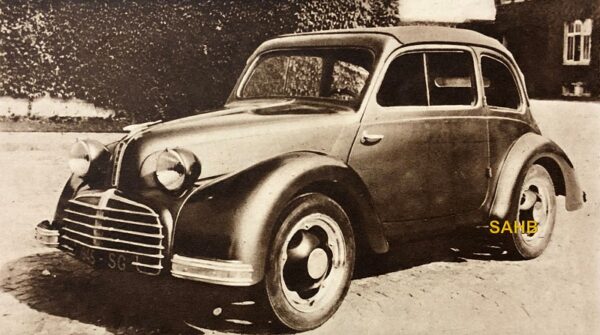
In December 1945 a picture appeared in The Sphere accompanied by a short caption announcing the imminent launch of a new Anglo-French car. Its name was not given, but the design was attributed to Grégoire and the patent rights had been acquired by the British company Grantham Productions Limited. Typical of a Grégoire design of the time, it was stated to use aluminium alloy for all the main members of the chassis, thus achieving a vehicle weight of only 800 lb. It would have a seating capacity of driver and three passengers, a petrol consumption of 71 mpg and a top cruising speed of 60 mph.
The tortuous story of the car dates back, however, to 1942, when J.A. Grégoire had designed the Aluminium Français prototype with this aluminium construction. Grégoire offered it to H.T. Pigozzi of Simca but this was vetoed by Fiat, then in majority control of Simca.
Meanwhile, Panhard had found to their horror that they had been left out of the post-war French government Pons Plan, which allocated raw materials only to a certain number of car manufacturers. To get round this, Jean Panhard decided to buy the Grégoire design, which would bring the full support of Aluminium Français to the Pons Plan and would secure the materials supplies to allow Panhard to continue motor car production.
The prototype had a cast aluminium frame with a 592cc air-cooled flat-twin engine in the front overhang, driving the front wheels. It had all-independent suspension with transverse leaf spring at the front and trailing arms and coil springs at the rear. But Panhard made many changes to Grégoire’s design to align it with their engineering and production philosophy. Their car was launched at the Paris Salon in October 1946 as the Dyna-Panhard.
Grégoire considered that his ideas had been corrupted by Panhard, and he set out in 1945 to sell his patented design elsewhere. Enter Denis Kendall, the local MP for Grantham. After a varied career in the motor industry the USA and France, and in munitions during the war, in November 1944 Kendall announced his intention to bring motoring to the masses through the development of a “people’s car”, available for just £100, plus £25 tax. He set up a new company called Grantham Productions Limited.
After the failure to produce two fatally flawed designs, Kendall learnt of the Grégoire prototype, and quickly signed an agreement to produce the car in Britain. The body, engine, transmission and suspension were to be manufactured at various locations in Britain, with assembly taking place in Grantham.
In April 1946, Motor Sport reported favourably on their visit to Grantham Productions to test the Kendall-Grégoire, stating that despite some weaknesses the car had potential for “the impecunious enthusiast.”
The project encountered severe difficulties and only five or six prototypes were built; none survive. Grantham Productions Limited went into receivership in November 1946, owing more than £445,000.
Jean-Albert Gregoire did find someone to make his car – Sir Lawrence J. Hartnett, an Englishman by birth, who had moved to Australia in 1934 as managing director of Holden. A few (perhaps 120) Hartnetts were manufactured in Melbourne, but the business was wound up in 1956.
Image courtesy of The Richard Roberts Archive: www.richardrobertsarchive.org.uk







Leave a Comment